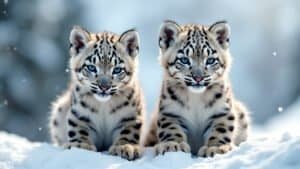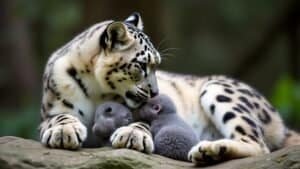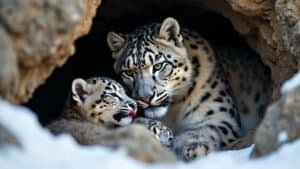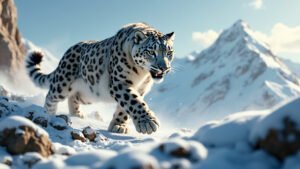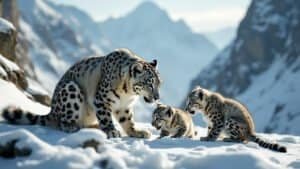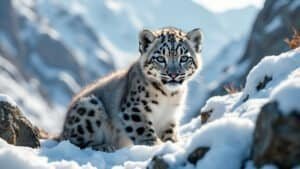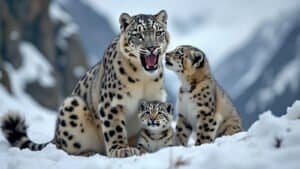Introduction
Snow leopard cubs face a unique journey toward independence in the harsh and unforgiving environments of the mountain ranges of Central and South Asia
This article explores the age at which snow leopard cubs typically leave their mothers, the skills they acquire during their early years, and the challenges they encounter as they venture into a solitary life
We will also delve into the critical role the mother plays in this process, the environmental factors that influence independence, and how these factors shape the cubs’ ability to survive on their own
At What Age Do Snow Leopard Cubs Become Independent?
Snow leopard cubs begin their journey toward independence within a specific age range, marking a crucial transition in their lives. Typically, snow leopard cubs become independent from their mothers between 18 to 24 months of age
This timeline can vary based on environmental factors, availability of prey, and individual development, but it generally aligns with the cubs’ growing ability to hunt and survive on their own
Typical Age Range for Independence
The age at which snow leopard cubs become independent is not arbitrary; it is a critical period in their development
Around 18 months, cubs have usually learned the essential skills required for survival in the harsh, mountainous habitats of Central and South Asia. By this time, they have practiced hunting and have become proficient at stalking prey, which typically includes ibex, blue sheep, and smaller mammals
At around two years old, the cubs are usually fully capable of hunting independently. The process of gaining independence, however, doesn’t happen overnight. It begins gradually as the mother starts to leave her cubs alone for longer periods
This process of gradual separation helps the cubs to become accustomed to solitude, a key aspect of snow leopard life since these big cats are solitary by nature
In some cases, cubs may stay with their mother slightly longer, up to 30 months, particularly if food is abundant or if the cubs are slower to develop hunting skills. This extended period can also be influenced by the mother’s assessment of her cubs’ readiness to face the challenges of independence
Factors Influencing Timing of Independence
Several factors can influence the timing of when a snow leopard cub becomes independent. One of the most significant factors is the availability of prey
In regions where prey is abundant, cubs may become independent earlier, as they can practice and perfect their hunting skills more quickly. Conversely, in areas where prey is scarce, the cubs might stay with their mother longer as they struggle to find sufficient food
Environmental conditions also play a crucial role. In harsh winters or in regions with severe weather, the cubs might delay their independence until conditions improve. The harsh terrain of the mountains requires them to be at peak physical condition before venturing out on their own
Human activity and habitat disturbance can also affect the timing of independence. In areas where snow leopards are under pressure from human encroachment or poaching, cubs may be forced to become independent earlier or, conversely, stay longer with their mothers if the environment is too dangerous
Differences Between Male and Female Cubs
Interestingly, there can be slight differences in the age of independence between male and female snow leopard cubs
Males, who generally require larger territories once independent, might stay with their mother a bit longer to build the strength and skills needed to secure and defend their territory. Female cubs, on the other hand, may become independent slightly earlier, as they often settle in territories closer to their mother’s range, where the competition is less intense
However, these differences are subtle and are heavily influenced by external factors such as prey availability and environmental conditions. Both male and female cubs must reach a level of proficiency in hunting and self-defense before they can leave their mother’s side and face the challenges of life alone in the rugged mountains
How Snow Leopard Cubs Learn Survival Skills
Snow leopard cubs must acquire a range of survival skills during their early months with their mother, as these skills are crucial for their survival in the harsh and unforgiving environments of the mountainous regions they inhabit
The learning process begins early and is intensely practical, as cubs observe and imitate their mother in various activities, from hunting to navigating the rugged terrain
Learning From the Mother
The mother snow leopard plays a pivotal role in teaching her cubs the necessary skills for survival. From the moment they are born, cubs are dependent on their mother for everything, including nourishment and protection. However, as they grow, the mother gradually introduces them to the skills they will need to survive on their own
The cubs begin by following their mother closely, observing her movements and actions. This period of observation is critical, as it allows the cubs to learn by example
The mother demonstrates how to stalk prey, approach it stealthily, and execute a successful kill. These hunting techniques are essential for the cubs’ future independence, as they will rely on their ability to hunt to sustain themselves once they leave their mother
In addition to hunting, the mother teaches her cubs how to navigate their rocky, mountainous habitat. Snow leopards are known for their agility and ability to traverse steep and rugged terrain. Cubs learn how to move silently and efficiently across these landscapes, a skill that is vital for both hunting and avoiding potential threats
Hunting Techniques and Practice
As the cubs grow older, the mother begins to involve them more actively in hunting
Initially, the cubs participate by watching their mother hunt, but as they develop, they start to engage in the hunt themselves. This practice is crucial, as it allows the cubs to refine their hunting techniques and build the physical strength needed to take down prey on their own
The mother may allow the cubs to practice on smaller or weaker prey, gradually increasing the difficulty of the hunts as the cubs’ skills improve. This hands-on practice is essential for the cubs to develop the precision and patience required for successful hunting
Cubs also learn how to deal with the challenges that come with hunting in such a harsh environment. This includes dealing with the cold, managing energy reserves during long hunts, and strategizing when to strike based on the behavior of the prey
These lessons are vital, as a single mistake in the wild can mean the difference between life and death
Adapting to the Harsh Environment
Surviving in the snow leopard’s natural habitat requires more than just hunting skills. Cubs must also learn how to cope with extreme weather conditions, including freezing temperatures and deep snow. The mother teaches the cubs how to find shelter during storms and how to conserve energy during periods of food scarcity
Snow leopard cubs also learn to avoid potential dangers in their environment. This includes avoiding predators and understanding the signs of human presence, which can pose a significant threat. Cubs are taught to be cautious and to remain hidden when necessary, using the rugged terrain to their advantage
Another important aspect of adapting to the environment is learning to identify safe and reliable sources of water. In the mountainous regions where snow leopards live, water can be scarce, especially during certain seasons. The mother shows her cubs where to find water and how to stay hydrated in their arid and cold habitats
Through this combination of observation, practice, and adaptation, snow leopard cubs acquire the comprehensive set of survival skills they need to thrive independently
These skills are the foundation upon which they will build their solitary lives, ensuring that they can successfully navigate the challenges of their environment and continue the snow leopard lineage
Challenges Faced by Snow Leopard Cubs After Independence
The transition to independence is a critical and challenging period for snow leopard cubs. Once they leave their mother’s side, these young leopards must face the harsh realities of survival on their own
The challenges they encounter range from establishing territory to avoiding predators and securing enough food in their rugged mountain habitats
Establishing Territory
One of the first challenges a snow leopard cub faces after becoming independent is establishing its own territory. Snow leopards are solitary animals, and each individual requires a large territory to secure enough prey and avoid conflicts with other snow leopards
The size of a snow leopard’s territory can vary widely depending on the availability of prey, but it often spans several square miles
For young snow leopards, finding and securing a territory is no easy task. They must venture into unfamiliar areas, often far from their mother’s range, to find a suitable location. This journey can be perilous, as they might encounter adult snow leopards who are fiercely territorial. In such encounters, young leopards must be prepared to defend themselves or flee to avoid injury
Moreover, snow leopards must be strategic in choosing their territory. It needs to be rich in prey and have access to water sources, yet also be secluded enough to avoid frequent encounters with humans or other threats
Establishing a territory is not just about claiming land; it’s about finding a place where they can survive and eventually thrive
Competition and Predation
Once a territory is established, the next challenge is dealing with competition and predation. Snow leopards are apex predators in their ecosystem, but that does not mean they are free from danger. Other predators, such as wolves or larger snow leopards, can pose significant threats to young, inexperienced leopards
Competition for prey can be fierce, particularly in regions where food is scarce. Young snow leopards must compete not only with other snow leopards but also with other carnivores in the area. This competition can be intense, and young leopards must use all the skills they have learned to secure enough food to sustain themselves
In addition to competition from other animals, snow leopards must also be wary of human threats. Poaching, habitat destruction, and conflicts with local herders are significant challenges that can endanger their lives. Young leopards, in particular, are vulnerable as they may not yet be fully adept at avoiding human encounters
Finding and Securing Food Sources
Securing a reliable food source is perhaps the most critical challenge for snow leopard cubs after independence. Snow leopards primarily hunt large prey such as ibex, blue sheep, and other mountain ungulates, but they will also hunt smaller animals when larger prey is not available. For a young snow leopard, successfully hunting large prey requires a combination of strength, strategy, and patience
The rugged terrain adds to the difficulty of hunting. Snow leopards must navigate steep cliffs, deep snow, and rocky outcrops while stalking their prey. Any mistake in timing or approach can result in a missed opportunity, leaving the leopard without a meal
Young snow leopards may also struggle with the physical demands of hunting. Taking down large prey requires a significant amount of energy and skill, and inexperienced leopards may find themselves expending more energy than they gain from their kills. This energy deficit can lead to starvation, particularly in harsh winters when prey is scarce
Another challenge is the need to store food or return to a kill site multiple times. Snow leopards often cover their kills with snow or debris to hide them from scavengers and return to feed over several days. However, young leopards must be cautious, as other predators or scavengers may discover the kill in their absence, leading to lost meals
Despite these challenges, snow leopards are remarkably resilient. Their solitary nature and the survival skills they learn from their mothers equip them to face these obstacles
Over time, as they gain experience and strength, they become adept hunters and defenders of their territory, securing their place in the harsh mountain ecosystems they call home
Role of the Mother Snow Leopard in Preparing Cubs for Independence
The mother snow leopard is central to her cubs’ survival, guiding them through their early months and ensuring they are prepared for the challenges of independence
Her role encompasses teaching essential survival skills, managing a gradual separation process, and, in some cases, continuing to monitor her cubs even after they begin to live independently
Teaching Essential Skills
From the moment they are born, snow leopard cubs rely entirely on their mother for sustenance and protection
As they grow, the mother slowly shifts from merely providing for them to actively teaching them how to fend for themselves. This teaching process is vital as it lays the groundwork for the cubs’ eventual independence
One of the first skills the mother imparts is how to hunt. Cubs watch their mother stalk and ambush prey, learning the patience and precision needed for successful hunting
Over time, the mother allows the cubs to participate in hunts, starting with small prey and gradually moving to larger, more challenging animals. This hands-on learning is critical; it ensures that by the time the cubs leave, they are capable hunters
In addition to hunting, the mother teaches her cubs about the terrain they inhabit. Snow leopards live in some of the most rugged and inhospitable environments on earth, and knowing how to navigate these landscapes is crucial for survival
The mother guides her cubs across steep cliffs, through dense snow, and around rocky outcrops, showing them how to move efficiently and safely in their mountainous home
Furthermore, the mother teaches the cubs how to avoid dangers, such as other predators and humans. This includes identifying safe resting spots, knowing when to retreat, and understanding the signs of a potential threat
These lessons are crucial, as young snow leopards must be able to recognize and react to danger to survive once they are on their own
Gradual Separation Process
The process of separation between a mother snow leopard and her cubs is gradual and deliberate. This slow transition helps the cubs build the confidence and skills needed to survive alone
The mother begins by leaving the cubs for short periods, gradually increasing the time she spends away from them. This teaches the cubs to cope with solitude, an essential aspect of snow leopard life, as these cats are solitary by nature
During these periods, the cubs are encouraged to explore their surroundings independently. They begin to hunt small prey on their own and learn to rely less on their mother for food. This gradual withdrawal of maternal support is designed to mimic the conditions the cubs will face once they are fully independent
The mother’s gradual retreat also includes reducing the amount of food she provides. As the cubs grow, they require more sustenance, and the mother increasingly expects them to contribute to their diet by hunting. This practice is vital for the cubs to learn the skills they need to survive once they are no longer under her care
The final stage of separation occurs when the mother leaves her cubs for extended periods, sometimes days at a time
This is the most critical phase, as it forces the cubs to hunt and fend for themselves entirely. By the time the mother leaves them permanently, the cubs should be fully capable of surviving on their own
Continued Monitoring After Independence
Even after her cubs have reached the point of independence, the mother snow leopard may continue to monitor them from a distance. This ongoing, albeit subtle, supervision is essential during the early stages of independence, as the cubs may still encounter challenges that test their survival skills
While the mother no longer provides direct support, her presence nearby can serve as a safety net in case of an immediate threat or failure in the cubs’ hunting efforts. The mother’s continued presence also helps to deter other adult snow leopards or predators from approaching the area where the young leopards are trying to establish themselves
In some cases, a mother snow leopard might even share a kill with her newly independent cubs if they struggle to secure food. This temporary support can be the difference between life and death for young leopards still honing their hunting skills
However, this period of continued monitoring is short-lived. As the cubs grow more confident and capable, the mother will eventually leave the area altogether, allowing her offspring to fully embrace their solitary existence
By this stage, the cubs have typically developed the skills and instincts necessary to thrive on their own, thanks in large part to the mother’s careful and gradual preparation
Environmental Factors Affecting Snow Leopard Cub Independence
The independence of snow leopard cubs is heavily influenced by various environmental factors. These factors range from the physical characteristics of their mountainous habitat to the availability of prey and the impacts of human activity
Each plays a critical role in determining the timing and success of a cub’s transition to independence
Impact of Habitat and Climate
The mountainous regions where snow leopards live are some of the harshest environments on Earth. These areas, which span across Central and South Asia, include the Himalayas, the Tibetan Plateau, and the Altai Mountains
The extreme conditions of these regions, including cold temperatures, deep snow, and rugged terrain, pose significant challenges for young snow leopards
The climate in these regions can be severe, with long winters and short, cool summers. Snow leopard cubs must learn to navigate these conditions and find shelter from the elements
The ability to survive in such a harsh climate is essential for their independence. Cubs that are not adequately prepared for the cold, for example, may struggle to find food or maintain their energy levels during the winter months
Seasonal changes also impact the availability of prey. During the winter, when snow covers the ground, hunting can become more difficult, and the prey may migrate to lower altitudes. This seasonal variation means that the timing of a cub’s independence might align with the availability of prey and the onset of more favorable conditions
For instance, a cub might delay its full independence until the spring or summer when food is more abundant and the weather less harsh
Availability of Prey
The availability of prey is perhaps the most significant environmental factor influencing the timing of snow leopard cub independence
Snow leopards primarily hunt large ungulates such as ibex, blue sheep, and argali. However, the abundance of these prey species can vary significantly based on location, season, and environmental conditions
In regions where prey is abundant, snow leopard cubs may become independent earlier because they have more opportunities to practice hunting and develop the skills needed to sustain themselves. A rich prey base allows cubs to experiment with different hunting techniques and refine their abilities without the constant threat of starvation
Conversely, in areas where prey is scarce, cubs might remain with their mother longer, as they may not have sufficient opportunities to hone their hunting skills. The scarcity of prey can lead to competition not only among young leopards but also with other predators in the area, making the process of becoming independent even more challenging
Furthermore, prey availability can fluctuate due to environmental factors such as harsh winters, droughts, or changes in vegetation patterns
These fluctuations can significantly impact the timing of independence, as snow leopard cubs must adapt to the changing conditions and availability of food
Human Influence and Conservation Efforts
Human activity is an increasingly significant factor affecting the independence of snow leopard cubs. As human populations expand into mountainous regions, snow leopards face habitat loss, reduced prey availability, and direct threats from poaching and retaliatory killings by herders
Habitat fragmentation caused by human encroachment can make it difficult for young snow leopards to establish territories. As roads, settlements, and livestock farms spread into snow leopard habitats, the available space for these big cats diminishes, leading to increased competition for the remaining territory and prey
Additionally, human activities such as mining, infrastructure development, and illegal hunting can reduce the populations of the snow leopard’s prey, forcing young leopards to travel greater distances in search of food
This increased effort to find prey can delay the process of gaining independence, as cubs may need more time to develop the necessary skills in a more challenging environment
On the positive side, conservation efforts are helping to mitigate some of these challenges. Various organizations and governments have implemented measures to protect snow leopard habitats, increase prey availability, and reduce human-wildlife conflict
These efforts include creating protected areas, promoting sustainable livestock management practices, and educating local communities about the importance of snow leopard conservation
Conservation initiatives also focus on monitoring snow leopard populations and ensuring that cubs have the best chance of survival by protecting critical habitats and reducing poaching. These efforts are essential for maintaining the delicate balance between human activities and the survival of snow leopards in the wild
Conclusion
Snow leopard cubs face a challenging journey to independence, typically beginning around 18 to 24 months of age. This process is influenced by a combination of factors, including the essential survival skills taught by their mother, the environmental conditions of their mountainous habitats, and the availability of prey
The mother snow leopard plays a crucial role in preparing her cubs for life on their own, guiding them through hunting practices, terrain navigation, and survival strategies. As the cubs transition to independence, they must overcome significant challenges, from establishing territories to competing for food and avoiding predators
Environmental factors, including climate, prey availability, and human influences, further shape the timing and success of their independence. Through this complex interplay of factors, snow leopard cubs gradually become self-sufficient, equipped to thrive in the harsh, solitary existence that defines their species


